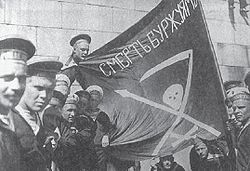Stepan Petrichenko
Stepan Maximovich Petrichenko (Russian: Степа́н Макси́мович Петриче́нко; 1892 – June 2, 1947) was a Russian
Life
Early years
Stepan Maximovich Petrichenko was born in 1892 in the village of Nikitenka in the
Soviet republic of sailors and builders

During the 1917
Kronstadt rebellion
After the rebellion was put down by
Emigrant
Petrichenko remained in exile in Finland for almost 25 years,[5] where his regard from fellow rebels remained high.[6]
He blocked further emigration to Helsinki, instead sending Kronstadt "volunteers" to
Agent
In 1922, Petrichenko went to
Arrest and death
On September 25, 1944, on the basis of an armistice agreement between the USSR, Great Britain and Finland, Petrichenko was released, and on April 21, 1945, he was again arrested and sent to the USSR, as part of a group of persons known as the "Prisoners of Leino", a list of political enemies and alleged military collaborators compiled by Soviet members of Allied Commission.[9] The investigation into Petrichenko was transferred from the police to the NKVD where it was examined without the presence of the prosecution or the defense. The verdict passed on November 17, 1945, read:[1]
Petrichenko, Stepan Maximovich, for participation in a counter-revolutionary terrorist organization and belonging to Finnish intelligence, is to be imprisoned in a forced labor camp for a period of 10 years, counting the period from April 24, 1945.
Stepan Petrichenko died on June 2, 1947, during his transfer from the Solikamsk labor camp to the Vladimir Central Prison.
Work
- Petrichenko, Stepan (1921). Pravda o kronshtadtskikh sobytiiakh. (Russian: Правда о кронштадтских событиях) (bibrec); English: The truth about the Kronstadt events
References
- ^ a b c d Prokhorov D. "The tragedy of the Kronstadt "rebel"" (in Russian). Archived from the original on March 4, 2016. Retrieved November 29, 2008.
- ^ "Naissaar. Republic of Soviets". Archived from the original on September 28, 2007. Retrieved January 15, 2020.
- ^ "Events in Kronstadt". Archived from the original on September 29, 2007. Retrieved January 15, 2020.
- ISBN 978-1-4008-5908-5.
- ^ Avrich 1970, p. 217.
- ^ Avrich 1970, p. 216.
- ^ M. Hosta, O. Lapchinsky, S. Kosher SPY DEATH
- ^ The beginning of 1940 (in Finnish).
- ^ Björkelund B.V. Travel to the land of all kinds of impossibilities / Prep. text for publication, scientific. ed., entry Art. and comm. S. A. Mankova. – SPb .: International Association of "Russian Culture", 2014.
External links
- The Truth about Kronstadt
- Kronstadt 1921
- "Den russiske revolution i farver" – En kritisk anmeldelse
- Kronstadt: Mentiras anarquistas
- Kronstadt rebellion
- Kronstadt Uprising
- Trotskyist account
Bibliography
- OCLC 67322.
